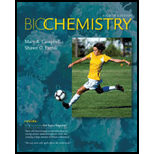
Concept explainers
RECALL What features distinguish enzymes that undergo allosteric control from those that obey the Michaelis–Menten equation?
Interpretation:
The difference between the enzymes that undergo allosteric control and the ones that obey the Michaelis–Menten equation is to be discussed.
Concept introduction:
The allosteric enzymes have multiple sites called allosteric sites. These enzymes change their shape when they bind to the substrate.
The binding of a molecule other than that of the substrate molecule can cause hindrance in the activity of the enzyme.
Answer to Problem 1RE
Solution:
The allosteric enzymes have multiple subunits and allosteric sites, whereas the Michaelis–Menten enzymes have a single active site, so there is a difference between the activities of these two enzymes. The rate of the concentration and substrate concentration graph for the allosteric enzyme is sigmoidal, while for the Michaelis–Menten enzyme, it is hyperbolic.
Explanation of Solution
The differences between the enzyme that undergo allosteric control and the ones that follow Michaelis–Menten equation are given in the table below:
| Allosteric enzyme | Michaelis-Menten enzyme |
| The allosteric enzymes have a number of allosteric sites or active sites. | These enzymes have a single active site to which a particular substrate can bind. |
| The multiple sites show the property of cooperativity, which means the binding of one molecule facilitates the binding of another molecule. | The substrate binds to the active site of the enzyme and leads to the formation of products. |
| The allosteric enzymes exist in two states: R-state and T-state. | The enzymes exist in a single native form only. |
| These enzymes show sigmoidal curve in the graph of reaction rate versus substrate concentration. | The enzymes show hyperbolic curve in the rate of the reaction versus substrate concentration graph. |
Hence, it can be concluded that the allosteric enzymes are unique as compared to the other enzymes because of their capability of adaptation to various conditions in the environment and are much different from the enzymes that follow Michaelis–Menten equation.
Want to see more full solutions like this?
Chapter 7 Solutions
Biochemistry
- Which type of enzyme catalyses the following reaction? oxidoreductase, transferase, hydrolase, lyase, isomerase, or ligase.arrow_forward+NH+ CO₂ +P H₂N + ATP H₂N NH₂ +ADParrow_forwardWhich type of enzyme catalyses the following reaction? oxidoreductase, transferase, hydrolase, lyase, isomerase, or ligase.arrow_forward
- Which features of the curves in Figure 30-2 indicates that the enzyme is not consumed in the overall reaction? ES is lower in energy that E + S and EP is lower in energy than E + P. What does this tell you about the stability of ES versus E + S and EP versus E + P.arrow_forwardLooking at the figure 30-5 what intermolecular forces are present between the substrate and the enzyme and the substrate and cofactors.arrow_forwardprovide short answers to the followings Urgent!arrow_forward
- Pyruvate is accepted into the TCA cycle by a “feeder” reaction using the pyruvatedehydrogenase complex, resulting in acetyl-CoA and CO2. Provide a full mechanismfor this reaction utilizing the TPP cofactor. Include the roles of all cofactors.arrow_forwardB- Vitamins are converted readily into important metabolic cofactors. Deficiency inany one of them has serious side effects. a. The disease beriberi results from a vitamin B 1 (Thiamine) deficiency and ischaracterized by cardiac and neurological symptoms. One key diagnostic forthis disease is an increased level of pyruvate and α-ketoglutarate in thebloodstream. How does this vitamin deficiency lead to increased serumlevels of these factors? b. What would you expect the effect on the TCA intermediates for a patientsuffering from vitamin B 5 deficiency? c. What would you expect the effect on the TCA intermediates for a patientsuffering from vitamin B 2 /B 3 deficiency?arrow_forwardDraw the Krebs Cycle and show the entry points for the amino acids Alanine,Glutamic Acid, Asparagine, and Valine into the Krebs Cycle - (Draw the Mechanism). How many rounds of Krebs will be required to waste all Carbons of Glutamic Acidas CO2?arrow_forward
 BiochemistryBiochemistryISBN:9781305961135Author:Mary K. Campbell, Shawn O. Farrell, Owen M. McDougalPublisher:Cengage Learning
BiochemistryBiochemistryISBN:9781305961135Author:Mary K. Campbell, Shawn O. Farrell, Owen M. McDougalPublisher:Cengage Learning
